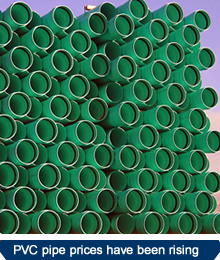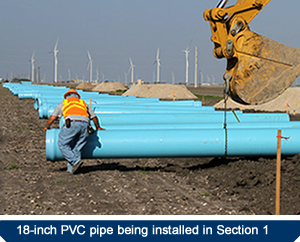April 27, 2011
In less than two months the price of PVC water transmission pipe shot up 35% to 50% and by April manufacturers had stopped quoting firm prices for future delivery.
That prompted the Water District to move quickly to purchase 10.5 miles of 12-inch pipe outright rather than wait and include it as part of an upcoming construction contract. In a special meeting the Board of Directors awarded a contract to Titan Pipe & Supply Co. of Corpus Christi, the low bidder at $641,440 ($11.99 per foot).
James Schwarz, consulting engineer to the District, explained that submitted bids were only good for one day because of the volatile PVC pipe market. Media reports indicate the volatility is driven by international demand for the resins used to make the pipe. Pipe prices had been lower during the worldwide economic slowdown, a fact that worked in the District’s favor on contracts awarded in 2009 and 2010.
The PVC pressure pipe will be installed as Section 2 of a transmission line that will provide treated drinking water to the City of Odem and the western service area of the Rincon Water Supply Corporation. A pipeline construction contract is scheduled for award in June. The line will connect to Section 1, a 3.5-mile run of 18-inch diameter PVC pipe completed in April. Section 1 starts at the new West Portland Pump Station and ends at the delivery point for the City of Taft.
 A 24-inch steel transmission line installed in 1952 has been serving the communities west of Portland and will serve as a backup to the new line. The condition of this 60-year-old line has deteriorated over time and it operates at reduced pressure in an effort to avoid further damage.
A 24-inch steel transmission line installed in 1952 has been serving the communities west of Portland and will serve as a backup to the new line. The condition of this 60-year-old line has deteriorated over time and it operates at reduced pressure in an effort to avoid further damage.
The 56,000 feet of PVC pipe for the new Section 2 line will be manufactured for the job in standard 20-foot sections. The contract requires that it meet the C900 specifications set by the American Water Works Association (AWWA) with a pressure specification (DR 25) of 165 psi. The pipe comes with an internal gasket system that creates watertight joints.
Medium and large diameter PVC pressure pipe has come into increasing use for water systems in the past 20 years because of its durability and ease of installation. PVC pipe of up to 36 inches was used to connect treatment, storage and pumping facilities added to the District’s water treatment complex over the past two years.
PVC Pressure Pipe Being Widely Used
Polyvinyl chloride (PVC) pipe now dominates the water distribution market. PVC pipe was first introduced to the U.S. in the 1950s and the AWWA first approved a set of pressure pipe specifications for 4-inch to 12-inch PVC in 1975. AWWA approved specification for pipe up to 36 inches in 1988 and increased the range up to 48 inches in 1997. By 2004 more than 75% of the water distribution pipe being installed annually in the U.S. was made of PVC.
PVC pipe has a range of properties that make it a versatile pipe material. It is corrosion resistant, an important attribute in locations where soils are chemically aggressive and can cause metal pipe to corrode and fail over time. The non-corrosive nature and resistance to chemical attack means PVC pipe is non-reactive with drinking water. PVC does not have the tensile strength of ductile iron which is the preferred material in many applications. Tensile strength is important because it resists the forces caused by internal hydrostatic pressure and water hammer that can cause pipe to burst.
PVC is light weight yet has adequate strength and flexibility to make it a forgiving material that can yield under loading without fracturing. Lighter weight plus simple push-together gasketed joints and flexibility combine to simplify the installation process. PVC pipe must be handled more carefully than ductile iron pipe during handling and installation to avoid scratches and gouges that could compromise long-term strength.
The 12-inch PVC pipe the District is purchasing has half-inch walls and weighs approximately 14.5 pounds per linear foot. Schwarz said he expects the contractor to be able to install more than a mile of pipe each week once the 10.5-mile project is underway.








